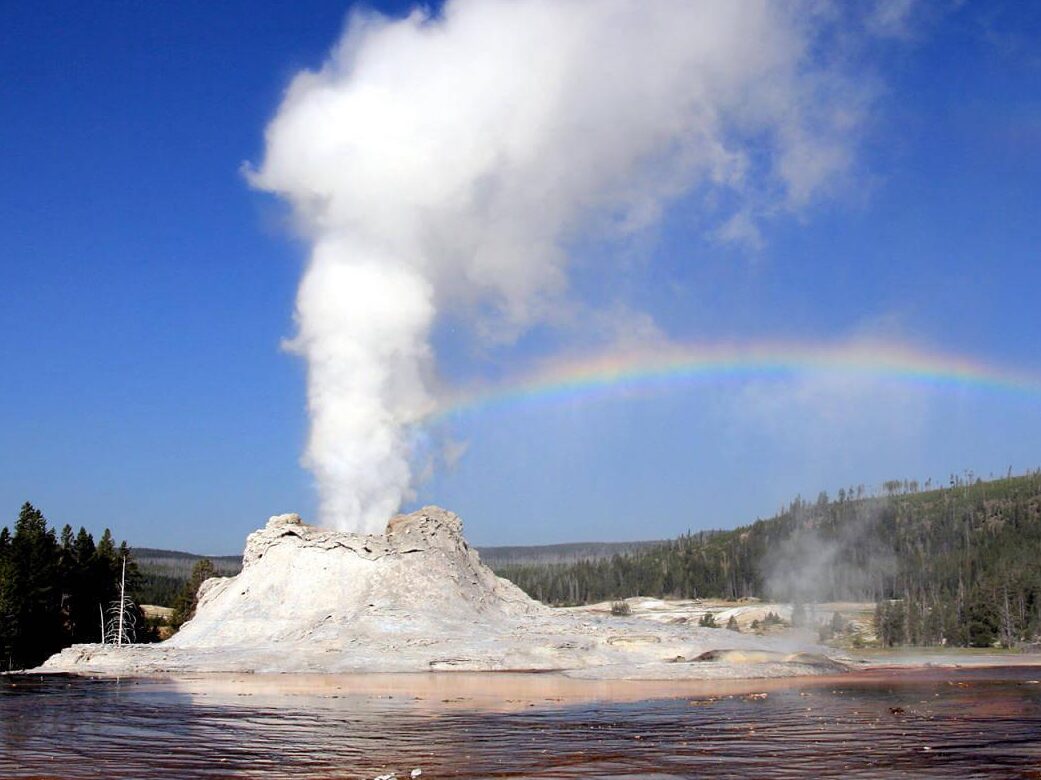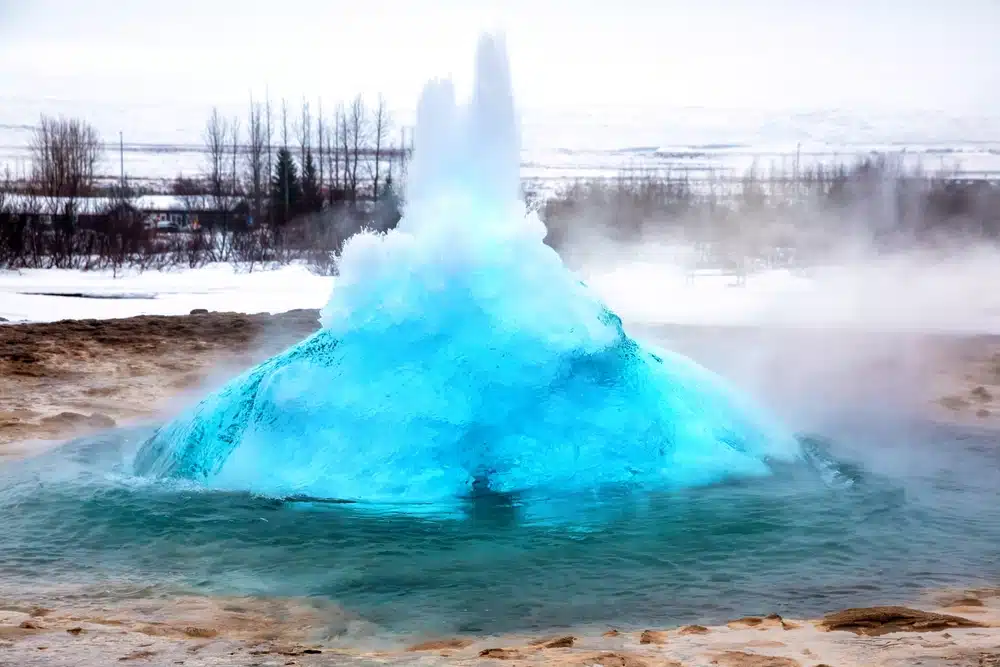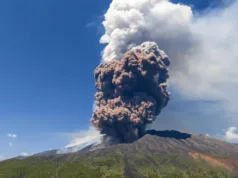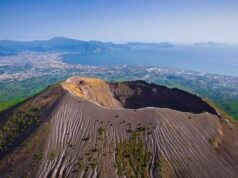A geyser is a natural phenomenon that consists of a hot spring that periodically erupts, sending a column of hot water and steam into the air. Geysers are rare and are typically found in geothermal areas with specific geological and hydrological conditions. They are most commonly associated with volcanic regions and areas with high levels of geothermal activity, such as Iceland, Yellowstone National Park in the United States, and the North Island of New Zealand.
Geysers form when water is heated by geothermal heat from the Earth’s interior, typically from magma or hot rocks beneath the surface. The heated water rises through conduits or channels in the ground, and as pressure builds up, it eventually erupts in a powerful burst, shooting water and steam into the air. The eruptions are often accompanied by a characteristic column of steam and can vary in height, frequency, and duration depending on the specific geyser.

Geysers can have different shapes and sizes, with some forming small bubbling pools and others forming large, towering eruptions reaching tens of meters in height. Some of the most famous geysers, such as Old Faithful in Yellowstone National Park, erupt with remarkable regularity, making them popular tourist attractions.
Geysers are unique natural wonders that offer insights into the Earth’s geothermal processes and are often regarded as symbols of the power and beauty of nature. However, they are delicate features that can be sensitive to changes in hydrological or geological conditions, and their formation and behavior can evolve over time. Proper conservation and management are necessary to protect and preserve these natural wonders for future generations to enjoy.

Importance of geysers in geology and geothermal systems
Geysers are significant features in geology and geothermal systems due to several reasons:
- Indicators of geothermal activity: Geysers are clear indicators of geothermal activity, which is the heat generated by the Earth’s internal processes. They often occur in areas with volcanic or geologically active landscapes, and their presence can signal the presence of geothermal reservoirs, where hot water and steam are stored in underground rock formations. By studying geysers, geologists can gain insights into the location, size, and behavior of these geothermal reservoirs, which can have practical applications for geothermal energy exploration and development.
- Hydrothermal processes: Geysers are formed by hydrothermal processes, which involve the interaction of water with heated rocks and minerals. These processes can alter the composition and structure of rocks, creating unique hydrothermal features and mineral deposits. Studying geysers can provide valuable information about these hydrothermal processes, including how they affect the surrounding geology, the types of minerals that form, and the conditions under which they occur. This knowledge can have implications for understanding ore deposits, geothermal systems, and other geological phenomena.
- Understanding geothermal fluid dynamics: Geysers are driven by the dynamics of geothermal fluids, which involve the movement of hot water and steam through underground conduits and channels. The eruptions of geysers are controlled by a complex interplay of factors, including the temperature, pressure, and chemistry of the geothermal fluids, as well as the characteristics of the conduit systems. By studying geysers, scientists can gain insights into the behavior and properties of geothermal fluids, which can improve our understanding of fluid dynamics in geothermal systems and other subsurface environments.
- Environmental and ecological significance: Geysers and their surrounding areas often support unique and fragile ecosystems that are adapted to the extreme conditions of high heat and mineral-rich waters. These ecosystems can provide valuable insights into how life can thrive in extreme environments and contribute to our understanding of astrobiology and the potential for life on other planets. Additionally, geysers and their surroundings are often protected areas with high ecological and cultural value, and proper management and conservation of these areas are crucial for preserving their biodiversity, cultural heritage, and recreational value.
In summary, geysers play an important role in geology and geothermal systems by serving as indicators of geothermal activity, providing insights into hydrothermal processes, enhancing our understanding of geothermal fluid dynamics, and contributing to environmental and ecological studies. They are unique natural features that offer valuable scientific, educational, and cultural significance, and their conservation and management are essential for their continued scientific and societal value.
Geological Setting of Geysers
The geological setting of geysers is closely tied to the presence of geothermal activity, which involves the transfer of heat from the Earth’s interior to the surface. Geysers are typically found in areas with specific geological characteristics that allow for the accumulation of heat and the formation of underground reservoirs of hot water and steam. The key geological components that contribute to the formation of geysers include:
- Volcanic or geologically active areas: Geysers are commonly associated with volcanic regions or areas with high levels of geothermal activity. Volcanic activity provides a heat source for geysers, as magma and hot rocks beneath the Earth’s surface can heat groundwater, creating a geothermal reservoir. The heat from volcanic activity can also create fractures, fissures, and conduits in the rock formations, which allow for the movement of hot water and steam to the surface and the eventual eruption of a geyser.
- Permeable rock formations: Geysers require permeable rock formations that allow water to circulate and accumulate underground. Permeable rocks, such as fractured and porous volcanic rocks or sedimentary formations like sandstone, can act as conduits for the movement of water and steam, allowing them to reach the surface and form geysers. These rock formations often have distinct layers of different types of rocks, which can influence the behavior and characteristics of geysers.
- Underground water supply: Geysers require a continuous supply of water from underground to sustain their eruptions. This typically comes from precipitation, which seeps into the ground and percolates through the permeable rock formations. The water then encounters the heat from the geothermal source, causing it to heat up and accumulate in underground reservoirs. Over time, pressure builds up as more water accumulates, leading to the eventual eruption of the geyser.
- Confined aquifers: Geysers are often associated with confined aquifers, which are underground water-bearing formations that are under pressure. Confined aquifers are typically located between impermeable layers of rock or clay, which trap the water and create pressure within the aquifer. This pressure can be released through fractures or conduits, leading to the periodic eruptions of geysers.
- Hydrothermal features: Geysers are part of a larger hydrothermal system that includes other geothermal features such as hot springs, fumaroles (steam vents), mud pots, and geothermal pools. These features are often found in close proximity to geysers and are indicative of the same underlying geothermal processes. They can provide additional clues about the geological setting of geysers and the characteristics of the geothermal system.
The combination of volcanic or geologically active areas, permeable rock formations, underground water supply, confined aquifers, and other hydrothermal features create the ideal geological setting for the formation of geysers. However, geysers are rare and require specific geological and hydrological conditions to form and sustain their eruptions, making them unique and fascinating natural wonders.

Formation and Operation of Geysers
The formation and operation of geysers involve a complex interplay of geology, hydrogeology, and thermodynamics. Geysers are formed and sustained by a combination of heat, water, and underground conduits that allow for the periodic eruptions of hot water and steam. The general process of geyser formation and operation can be summarized in the following steps:
- Heat Source: Geysers require a heat source to heat the water and create the pressure necessary for eruptions. This heat typically comes from volcanic activity or other geothermal processes, where hot rocks or magma heat the surrounding groundwater. The heat source provides the energy needed to drive the geyser eruption.
- Underground Reservoir: As the groundwater is heated by the heat source, it accumulates in underground reservoirs. These reservoirs are typically located in permeable rock formations, such as fractured volcanic rocks or sedimentary formations, where water can circulate and accumulate. The water in the reservoir becomes superheated, reaching temperatures above its boiling point but remaining in a liquid state due to the high pressure.
- Conduit System: Geysers require a conduit system that allows the water and steam to rise from the underground reservoir to the surface. This conduit system typically consists of narrow channels or pipes within the rock formations that connect the underground reservoir to the surface. Over time, these conduits can become partially blocked by mineral deposits or debris, creating pressure buildup in the underground reservoir.
- Eruption Cycle: When the pressure in the underground reservoir becomes high enough, it overcomes the resistance in the conduit system, causing an eruption. The eruption typically starts with a sudden release of steam and water, followed by a period of intense boiling and splashing. The eruption can last from a few minutes to several hours, depending on the size and characteristics of the geyser. Once the eruption is over, the geyser goes into a period of rest, and the process begins again with the accumulation of water in the underground reservoir and the gradual buildup of pressure.
- Recharge Phase: After the eruption, the underground reservoir needs to be replenished with water for the next cycle. This occurs during the recharge phase, where water from precipitation or other sources replenishes the underground reservoir. The recharge phase can last for hours to days or even longer, depending on the size and characteristics of the geyser and the availability of water.
The formation and operation of geysers are complex and dynamic processes that are influenced by various geological, hydrogeological, and thermodynamic factors. The unique combination of heat, water, and underground conduits creates the ideal conditions for geysers to form and operate, resulting in the spectacular eruptions that are characteristic of these natural wonders.

Types and Characteristics of Geysers
Geysers can be classified into different types based on their eruptive characteristics and the nature of their eruptions. Here are some of the common types of geysers:
- Cone Geysers: These geysers have a cone-shaped mound of mineral deposits, usually silica, that forms around the vent where the eruptions occur. The cone is built up over time as mineral-rich water is sprayed out during eruptions and then solidifies upon contact with air. Cone geysers tend to have frequent, shorter eruptions, and the cone shape can vary in size and shape depending on the specific geyser.
- Fountain Geysers: These geysers erupt with a tall, vertical column of water and steam that is typically not accompanied by a pronounced cone formation. Fountain geysers have eruptions that are more like a continuous fountain or gush of water rather than a periodic eruption with distinct resting phases. They often have a more irregular eruption pattern compared to cone geysers.
- Fountain Paint Pot Geysers: These geysers are characterized by their thick, pasty mud-like eruptions, which are a mix of water, steam, and clay or silica-rich mud. The eruptions are typically not as tall or forceful as cone or fountain geysers, but they can be visually interesting due to the mud-like consistency of the eruptions.
- Steam Geysers: These geysers primarily erupt with steam rather than water, and they may not have a visible water column during eruptions. Steam geysers are typically found in areas where the water supply to the geyser is limited, or the underground conduit system is partially blocked, allowing only steam to escape during eruptions.
- Geyserettes: These are smaller geysers that have relatively low eruptions and may not have a pronounced cone or vent structure. Geyserettes are often associated with larger geysers and are considered as “baby geysers.” They can have unique and diverse eruptive characteristics and are often visually appealing.
The characteristics of geysers can vary greatly depending on factors such as the size of the conduit system, the nature of the underground reservoir, the available water supply, and the surrounding geology. Some geysers may have regular and predictable eruptions, while others may be more irregular and sporadic. The size and shape of the cone or vent structure, the height of the eruptions, the duration of the eruptions, and the composition of the eruptions (water, steam, mud, etc.) can all vary among different types of geysers. These unique characteristics make geysers fascinating natural features and popular attractions for tourists and geologists alike.
Geothermal Energy from Geysers
Geysers are a natural manifestation of geothermal energy, and they can be utilized as a source of renewable energy. Geothermal energy is the heat energy that is stored in the Earth’s crust, primarily in the form of hot water and steam. Geysers provide an opportunity to harness this geothermal energy and convert it into useful electricity or heat for various applications.
Geothermal energy from geysers can be extracted through the following process:
- Resource Assessment: First, geothermal resources, including geysers, need to be assessed to determine their potential for energy production. This involves studying the geology, hydrogeology, and thermodynamic characteristics of the geyser, as well as its past eruptive behavior and recharge patterns. Data such as temperature, pressure, and flow rates of the geothermal fluids are collected to determine the feasibility of utilizing the geyser as an energy source.
- Drilling: Once a geothermal resource, including a geyser, is identified, wells are drilled into the ground to access the underground reservoir of hot water or steam. Production wells are drilled to tap into the high-pressure water or steam below the ground and bring it to the surface.
- Fluid Extraction: The hot water or steam from the geyser is extracted through the production wells and brought to the surface. The fluid is then separated from any dissolved gases or solids and is utilized for various purposes, such as power generation or direct use in heating applications.
- Power Generation: The extracted hot water or steam can be used to generate electricity through various techniques. One common method is to use the high-pressure steam to drive a turbine, which in turn generates electricity. The spent geothermal fluid, after passing through the turbine, is then re-injected into the ground to replenish the geothermal reservoir and sustain the geyser’s operation.
- Direct Use: The hot water or steam from geysers can also be utilized directly for heating purposes. For example, it can be used for district heating, where the hot water or steam is distributed through a network of pipes to heat buildings, greenhouses, or industrial processes.
- Environmental Considerations: It is essential to consider the potential environmental impacts of geothermal energy production, including the utilization of geysers. These may include the discharge of fluids that contain dissolved minerals or gases, the alteration of the geyser’s natural eruptive behavior, and the potential for subsidence or ground deformation. Proper monitoring, management, and mitigation measures need to be in place to ensure sustainable and environmentally responsible geothermal energy production from geysers.
Geothermal energy from geysers is considered a reliable and renewable source of energy that can provide a continuous and stable supply of electricity or heat. It is also a clean energy source, as it produces minimal greenhouse gas emissions and air pollutants compared to fossil fuels. However, the utilization of geysers for geothermal energy production requires careful planning, monitoring, and management to ensure sustainable and responsible utilization of these unique natural features.
Geysers as Geological and Hydrogeological Indicators
Geysers can serve as valuable indicators of geological and hydrogeological processes, providing insights into the geology, hydrogeology, and thermal characteristics of the subsurface. Here are some ways in which geysers can be used as geological and hydrogeological indicators:
- Geothermal Activity: Geysers are a visible manifestation of geothermal activity, indicating the presence of high-temperature fluids and heat flow in the subsurface. The presence of a geyser can be indicative of a geothermal system, where hot water or steam is being generated by the heat from the Earth’s interior. The study of geysers can provide valuable information about the geological formations, such as geothermal reservoirs, fractures, and faults, that are responsible for the high-temperature fluids reaching the surface.
- Hydrogeology: The operation of a geyser is dependent on the availability of an adequate supply of water, which is heated by geothermal heat and then erupted as steam and water. The study of geysers can provide insights into the hydrogeology of the subsurface, including the source, movement, and circulation of water in the underground aquifers. Observations of changes in geyser behavior, such as variations in eruption frequency or duration, can provide clues about changes in the hydrogeological conditions, such as water recharge rates or aquifer properties.
- Rock and Mineral Alteration: Geysers can cause alteration of rocks and minerals in the vicinity of their eruption sites. The hot water and steam from geysers can interact with the rocks, leading to various types of mineral deposition and alteration, including the formation of sinter, travertine, and geyserite. The study of these minerals and their spatial distribution can provide insights into the composition and properties of the rocks and minerals in the subsurface, as well as the geochemical processes that occur during the geysers’ operation.
- Volcanic Activity: Some geysers are associated with volcanic activity, as they occur in volcanic regions where there is a presence of magma or volcanic heat sources. The study of geysers can provide information about the relationship between the geothermal activity and the volcanic activity in the area. Changes in geyser behavior, such as increased eruption frequency or changes in eruption style, can be indicative of changes in the volcanic activity, such as magma movement or pressure changes in the volcanic system.
- Climate and Environmental Changes: Geysers are sensitive to changes in climate and environmental conditions. Variations in precipitation, temperature, and groundwater levels can affect the operation of geysers, leading to changes in their eruption patterns and behavior. Long-term monitoring of geysers can provide valuable data on climate and environmental changes, helping to understand the impacts of climate change on hydrogeological systems and geothermal resources.
Overall, geysers can serve as important indicators of geological and hydrogeological processes, providing valuable insights into the subsurface geology, hydrogeology, and thermal characteristics of a region. The study of geysers can contribute to our understanding of geothermal systems, volcanic activity, rock and mineral alteration, and environmental changes, and can be used in the exploration and management of geothermal resources.
Summary of key points of Geysers
Geysers are natural geothermal features characterized by intermittent eruptions of hot water and steam from the ground.
Key points about geysers include:
- Definition and Description: Geysers are hydrothermal features that occur in geologically active areas with geothermal heat sources and abundant groundwater. They are characterized by intermittent eruptions of hot water and steam from the ground, driven by pressure and heat from geothermal reservoirs.
- Geological Setting: Geysers are typically found in volcanic or geothermal areas, where there is a combination of heat from the Earth’s interior, suitable geologic formations, and an adequate supply of water from precipitation or groundwater.
- Formation and Operation: Geysers form and operate through a complex interplay of geology, hydrogeology, and thermal processes. Hot water and steam are generated by geothermal heat, and pressure builds up in underground reservoirs until it is released in explosive eruptions, followed by periods of quiescence.
- Types and Characteristics: Geysers can vary in size, shape, eruption style, and behavior. They can be categorized into various types based on their eruption patterns, such as cone geysers, fountain geysers, and geyserettes, among others. The duration, height, and frequency of eruptions can also vary greatly among geysers.
- Geothermal Energy: Geysers are a significant source of geothermal energy, which can be harnessed for electricity generation and heating. Geothermal power plants utilize the hot water and steam from geysers to generate electricity, providing a renewable and sustainable source of energy.
- Geological and Hydrogeological Indicators: Geysers can provide valuable insights into the geology, hydrogeology, and thermal characteristics of the subsurface. They can serve as indicators of geothermal activity, hydrogeological processes, rock and mineral alteration, volcanic activity, and climate and environmental changes.
Geysers are fascinating natural features that are not only visually stunning but also hold important scientific and practical significance. They offer unique opportunities for studying the geology, hydrogeology, and thermal processes of the Earth’s subsurface, and they have practical applications in geothermal energy production.
Geysers FAQ
Q: What is a geyser?
A: A geyser is a hydrothermal feature characterized by intermittent eruptions of hot water and steam from the ground. It occurs in geologically active areas with geothermal heat sources and abundant groundwater.
Q: How do geysers form?
A: Geysers form through a complex interplay of geology, hydrogeology, and thermal processes. Hot water and steam are generated by geothermal heat, and pressure builds up in underground reservoirs until it is released in explosive eruptions, followed by periods of quiescence.
Q: Where are geysers typically found?
A: Geysers are typically found in volcanic or geothermal areas, where there is a combination of heat from the Earth’s interior, suitable geologic formations, and an adequate supply of water from precipitation or groundwater.
Q: What types of geysers are there?
A: Geysers can be categorized into various types based on their eruption patterns, such as cone geysers, fountain geysers, and geyserettes, among others. These types vary in size, shape, eruption style, and behavior.
Q: What is the importance of geysers in geology and geothermal systems?
A: Geysers are important in geology and geothermal systems as they provide insights into the geology, hydrogeology, and thermal characteristics of the subsurface. They can serve as indicators of geothermal activity, hydrogeological processes, rock and mineral alteration, volcanic activity, and climate and environmental changes. Geysers are also a significant source of geothermal energy, which can be harnessed for electricity generation and heating.
Q: Can geysers be used for geothermal energy production?
A: Yes, geysers are a significant source of geothermal energy. Geothermal power plants utilize the hot water and steam from geysers to generate electricity, providing a renewable and sustainable source of energy.
Q: What are the safety precautions for visiting geysers?
A: Visiting geysers can be dangerous due to the high temperatures and steam eruptions. It is important to follow all posted signs, stay on designated trails, and never approach or touch a geyser. The ground around geysers can be unstable, and hot water and steam eruptions can be unpredictable. It is important to exercise caution and adhere to safety guidelines provided by park authorities or local regulations.
Q: Can geysers change in behavior over time?
A: Yes, geysers can change in behavior over time. Eruption patterns, frequency, duration, and intensity of geysers can vary over years or decades due to changes in hydrogeological conditions, thermal activity, and other factors. Monitoring and studying geysers over time can provide valuable insights into their dynamics and changes in behavior.
Q: Can geysers go extinct?
A: Yes, geysers can go extinct. Changes in hydrogeological conditions, geothermal activity, or human activities such as groundwater extraction or geothermal energy production can potentially impact the functioning of geysers and even lead to their extinction. Conservation efforts and responsible management practices are important for preserving geysers for future generations.
Q: Can geysers be found on other planets or moons?
A: Geysers have been observed on other celestial bodies in our solar system, such as Jupiter’s moon, Europa, and Saturn’s moon, Enceladus. These geysers are believed to be driven by tidal forces and internal heating, and studying them can provide insights into the geological and thermal processes of these distant worlds.




































